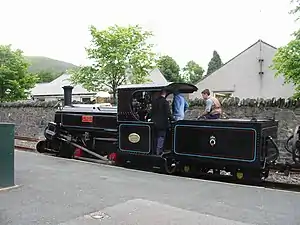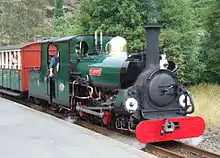Penrhyn Main Line class
The Penrhyn Main Line class was a class of three narrow gauge steam locomotives built for the Penrhyn Quarry Railway (PQR). These locomotives were built by the Hunslet Engine Company between 1882 and 1893 and supplied specifically to work the railway that connected the Penrhyn Quarry near Bethesda in north Wales to Port Penrhyn on the Menai Strait.[1]
| Penrhyn Main Line class | |||||||||||||||||||||||||
|---|---|---|---|---|---|---|---|---|---|---|---|---|---|---|---|---|---|---|---|---|---|---|---|---|---|
 | |||||||||||||||||||||||||
| |||||||||||||||||||||||||
| |||||||||||||||||||||||||
| |||||||||||||||||||||||||
Penrhyn Quarry Railway
The original locomotives to work the "main line" of the PQR were a series of vertical boilered De Winton locomotives delivered in 1879. These proved inadequate for the task of moving substantial quantities of slate over the railway and in 1882 a more conventional locomotive was ordered from Hunslet to work the railway. This was the first of the "Main Line class" locomotives Charles. Charles was joined in 1893 by two more locomotives to the same design but slightly enlarged, which were named Linda and Blanche. These were the sole locomotives built to this design.[2]
Preservation
All three locomotives were preserved after the closure of the PQR. Charles was donated to the Penrhyn Castle Railway Museum.
Linda was loaned to the nearby Ffestiniog Railway in July 1962. For the 1963 season the locomotive was regauged to the Ffestiniog's 1 ft 11 1⁄2 in (597 mm) and purchased, along with Blanche at the end of the year. Both have since received extensive modifications including tenders, pony trucks and superheating.[2]
Technical specification
The following technical specification are for the locomotives as delivered from Hunslet and are from[1] unless otherwise stated:
| Charles | Linda and Blanche | |
|---|---|---|
| Boiler grate area | 4.5 sq ft (0.42 m2) | 5.2 sq ft (0.48 m2) |
| Boiler pressure | 140 lbf/in2 (970 kPa) | 140 lbf/in2 (970 kPa) |
| Water storage | 500 gallon Saddle tank | 500 gallon Saddle tank |
| Cylinders | Two, outside, 10 in × 12 in (254 mm × 305 mm)[3] | Two, outside, 10.5 in × 12 in (267 mm × 305 mm) |
| Driving wheels | 2 ft 1 in (635 mm) diameter[3] | 2 ft 1 in (635 mm) diameter[3] |
| Wheelbase | 5 ft 0 in (1.52 m)[3] | 5 ft 0 in (1.52 m)[3] |
| Front overhang | 5 ft 7 in (1.70 m) | 5 ft 7 in (1.70 m) |
| Rear overhang | 6 ft 0 in (1.83 m) | 6 ft 3 in (1.91 m) |
| Tractive effort | 5,050 lbf (22.46 kN) | 5,550 lbf (24.69 kN) |
.jpg.webp) Charles at Penrhyn Castle
Charles at Penrhyn Castle Blanche running on the Ffestiniog Railway as a 2-4-0 with tender
Blanche running on the Ffestiniog Railway as a 2-4-0 with tender
See also
- Ruislip Lido Railway – Mad Bess is a 12-inch (305 mm) gauge miniature railway locomotive based on Blanche
References
- Boyd, James I.C. (1985). Narrow Gauge Railways in North Caernarvonshire: Volume 2 the Penrhyn Quarry Railways. The Oakwood Press. ISBN 0853613125.
- Blenkinsop, Dick (1993). Linda & Blanche: Penrhyn to Festiniog. AB Publishing. ISBN 1869915054.
- Penrhyn Castle Industrial Museum (3rd ed.). The National Trust. 1982.
External links
- "Fabrication of a complete new boiler for Blanche". Ricket Rescue.